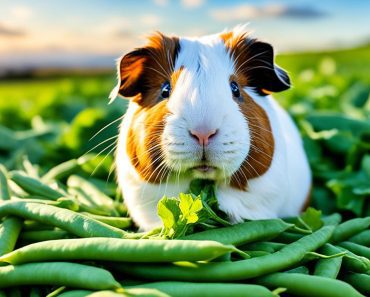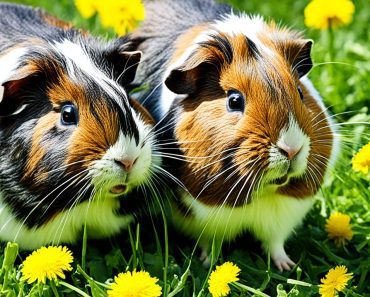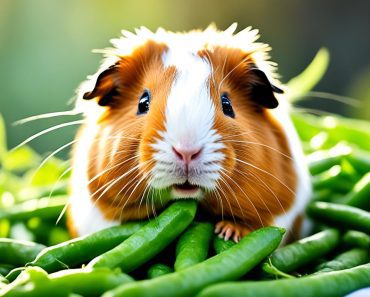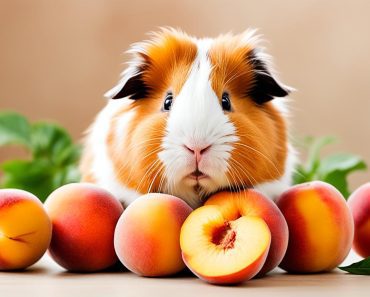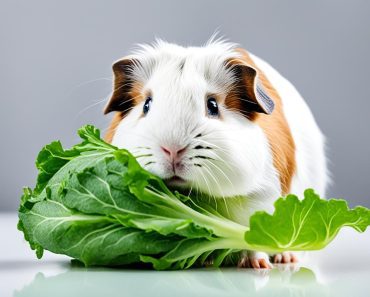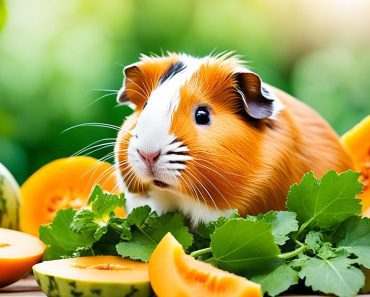As a guinea pig owner, I always strive to provide the best care and nutrition for my furry friends. One question that often comes up is: can guinea pigs eat celery? After doing my research and consulting with veterinarians, I’m here to share my feeding tips and insights about including celery in a guinea pig’s diet.
First and foremost, the good news is that guinea pigs can safely enjoy celery as part of their diet. This crunchy vegetable contains essential vitamins A, C, and K, which are important for their overall health. Vitamin C, in particular, is crucial for guinea pigs to prevent scurvy, and celery provides a natural source of this vital nutrient.
However, it’s important to remember that moderation is key when it comes to feeding celery to guinea pigs. While it offers nutritional benefits, celery is also high in oxalates and calcium. Overfeeding can lead to urinary tract problems and bladder stones, which can be uncomfortable and potentially harmful to your guinea pig’s health.
My feeding tip is to offer celery to your guinea pigs a few times a week as a snack, in small amounts. It’s best to cut the celery into bite-sized pieces to prevent choking, and ensure that you wash it thoroughly to remove any pesticides or dirt that may be present.
Can Guinea Pigs Eat Celery? Yes! They can perfectly do so.
- Celery is safe for guinea pigs to eat but should be offered in moderation.
- It is a good source of vitamins A, C, and K, which contribute to their overall health.
- Guinea pigs should be given small amounts of celery a few times a week as a snack.
- Ensure that the celery is washed thoroughly and cut into bite-sized pieces to prevent choking.
- Remember that celery is high in oxalates and calcium, so overfeeding can lead to urinary tract problems and bladder stones.
The Benefits of Celery for Guinea Pigs
Celery provides several benefits for guinea pigs.
- Rich in Vitamin C: Celery is a good source of vitamin C, which is essential for the immune system and overall health of guinea pigs. Vitamin C helps in the production of collagen, the formation of red blood cells, and the absorption of iron.
- Hydration: Celery has a high water content, which helps keep guinea pigs hydrated. Hydration is important for proper digestion and to prevent urinary tract problems in guinea pigs.
- Dental Health: The crunchy texture of celery promotes dental health in guinea pigs. Chewing on celery helps wear down their continuously growing teeth, keeping them at a healthy length. This helps prevent dental issues such as overgrowth or malocclusion.
However, it’s important to offer celery in moderation as part of a balanced diet. Guinea pigs need a variety of vegetables, hay, and pellets to meet their nutritional needs. Celery should be given as a snack a few times a week, along with other vegetables. Remember to cut celery into small, bite-sized pieces to prevent choking hazards.
Considerations When Feeding Celery to Guinea Pigs
When it comes to feeding celery to your beloved guinea pigs, there are a few important considerations to keep in mind to ensure their health and well-being. Let’s delve into these key factors:
1. Thoroughly Wash the Celery
Before offering celery to your guinea pigs, it is essential to wash it thoroughly. This step helps remove any potential pesticides or dirt, ensuring that your furry friends enjoy a safe and clean snack.
2. Cut Into Bite-Sized Pieces
Celery should be cut into small, bite-sized pieces to prevent any risk of choking. By taking this precaution, you can ensure that your guinea pigs can easily and safely chew and swallow the celery without any complications.
3. The Leaves Are Safe to Eat Too
Don’t forget to include the celery leaves in your guinea pigs’ diet! The leaves are entirely safe for them to eat and can provide additional variety and nutrients. Be sure to include both the stalks and leaves when preparing their delicious celery snack.
4. Avoid Feeding Cooked Celery
While it may be tempting to feed cooked celery to your guinea pigs, it’s best to stick to raw celery. Cooked celery has fewer nutrients and can be more difficult for guinea pigs to digest properly. Opt for raw celery to ensure they receive maximum nutrition from this healthy vegetable.
5. Celery as a Treat, Not a Main Component
Remember that celery should be given to guinea pigs as a treat, not as a main component of their diet. While it provides valuable vitamins and hydration, it should be offered in moderation. Ensure that the main components of their diet consist of other safe vegetables, hay, and the guidance of a trusted veterinarian.
By following these considerations, you can confidently include celery in your guinea pigs’ diet, providing them with a delicious and nutritious snack while prioritizing their health and well-being.
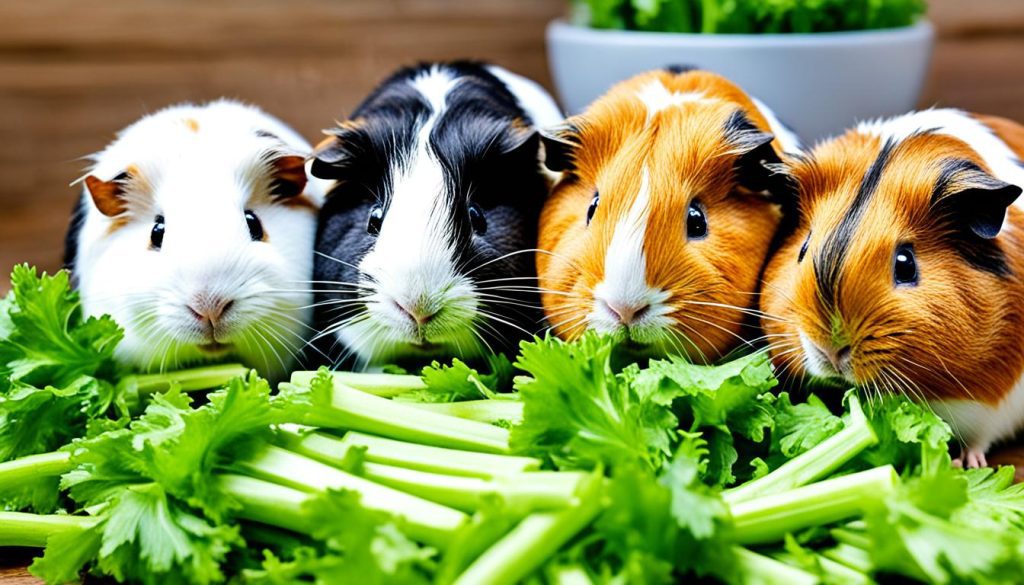
| Considerations | Guidelines |
|---|---|
| Wash the Celery | Thoroughly wash the celery to remove pesticides or dirt. |
| Cut Into Bite-Sized Pieces | Ensure the celery is cut into small, safe pieces to prevent choking. |
| The Leaves Are Safe to Eat | Include both the celery stalks and leaves in their diet for variety. |
| Avoid Cooked Celery | Stick to feeding raw celery for maximum nutrition and ease of digestion. |
| Celery as a Treat | Offer celery as a treat a few times a week – not as the main component of their diet. |
Other Safe Vegetables for Guinea Pigs
In addition to celery, there are several other safe vegetables that you can incorporate into your guinea pig’s diet. These vegetables provide a variety of essential nutrients and can help keep your guinea pig healthy.
Bell Peppers
Bell peppers are a great addition to your guinea pig’s diet. They are rich in vitamin C, which is crucial for their immune system health. Bell peppers also provide other vitamins and minerals that contribute to their overall well-being. You can offer small pieces of different-colored bell peppers to add variety to their meals.
Carrots
Carrots are another safe vegetable that guinea pigs can enjoy. They are a good source of vitamin A, which supports their vision and skin health. Carrots are also crunchy, which helps promote dental health by encouraging natural chewing. Remember to cut carrots into small, manageable pieces to prevent choking.
Cucumbers
Cucumbers are hydrating and low in calories, making them an excellent choice for guinea pigs. They provide hydration while offering a refreshing snack. Like other vegetables, cucumbers should be sliced into small, bite-sized portions before being offered to your guinea pig.
Leafy Greens
Leafy greens such as lettuce and spinach are packed with vitamins and minerals that contribute to guinea pig nutrition. They are a good source of fiber, which aids digestion and helps maintain a healthy weight. Offer a variety of leafy greens to provide a balanced diet for your guinea pig.
When incorporating new vegetables into your guinea pig’s diet, it’s essential to introduce them gradually and monitor your pet for any adverse reactions. Remember to consult with a veterinarian for specific dietary recommendations based on your guinea pig’s individual needs.
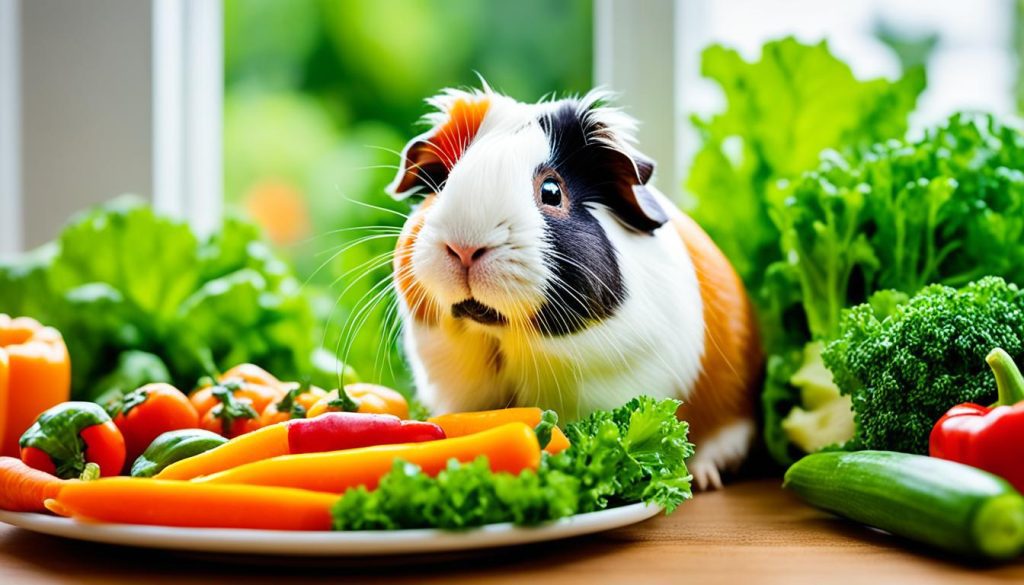
| Vegetable | Nutritional Benefits |
|---|---|
| Bell Peppers | – High in vitamin C – Contains other essential vitamins and minerals |
| Carrots | – Rich in vitamin A – Promotes dental health |
| Cucumbers | – Hydrating – Low in calories |
| Leafy Greens (Lettuce, Spinach) | – Excellent source of fiber – Provides essential vitamins and minerals |
Conclusion
Incorporating celery into your guinea pig’s diet can be a healthy choice. Celery provides important vitamins, such as vitamin C, and hydration for your furry friend. However, it’s important to remember that moderation is key due to celery’s high oxalates and calcium content. Feeding celery as a snack a few times a week, in small pieces, is recommended.
While celery can be a great addition to your guinea pig’s diet, it should not be the main component. Remember to include other safe vegetables, such as bell peppers, carrots, cucumbers, and leafy greens, along with hay to ensure your guinea pig gets all the necessary nutrients.
To ensure the well-being of your guinea pig, it’s always a good idea to consult with a veterinarian who can provide specific dietary recommendations. By following these guidelines and consulting with a professional, you can safely introduce celery into your guinea pig’s diet, providing them with a well-rounded and nutritious meal plan.

